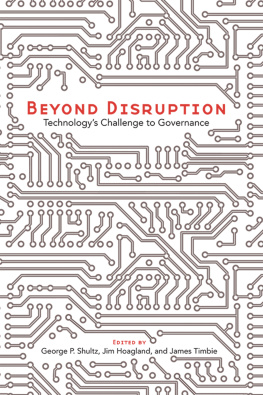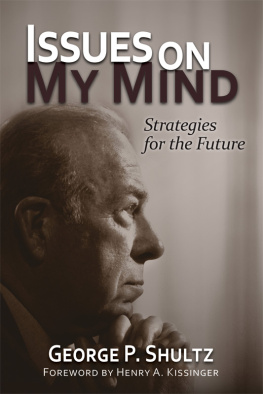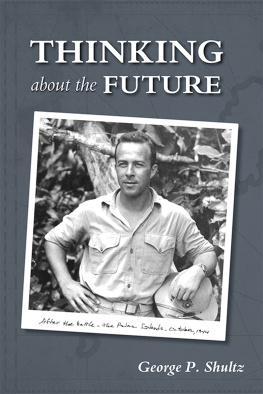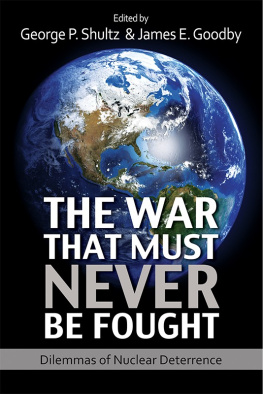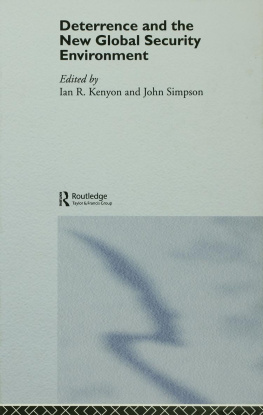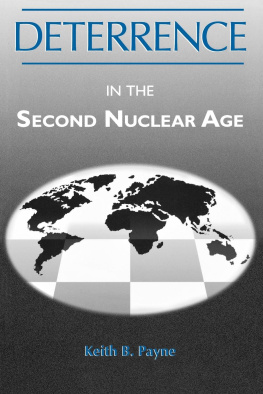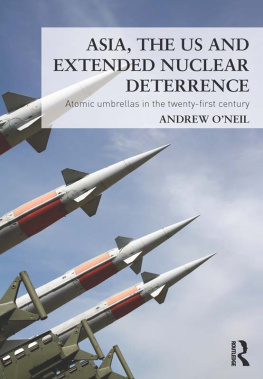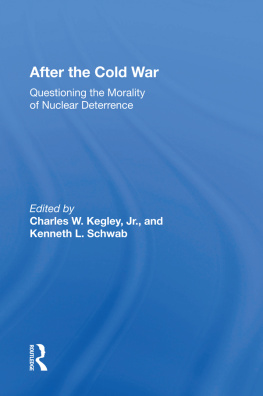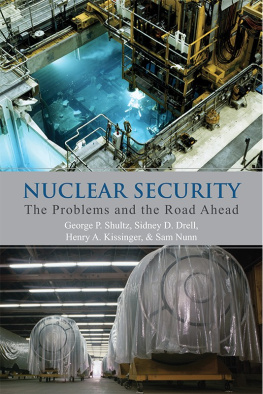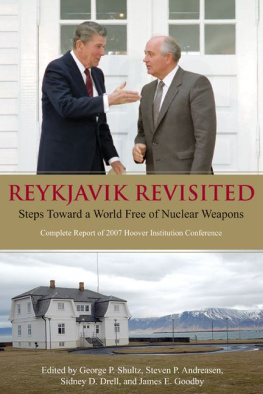 | The Hoover Institution gratefully acknowledges the following individuals and foundations for their significant support of this publication: T HE W ILLIAM AND F LORA H EWLETT F OUNDATION M R. AND M RS. W ILLIAM O BERNDORF |
Papers Presented at
Hoover Institution, November 2010
Edited by
George P. Shultz, Sidney D. Drell, and James E. Goodby
H O O V E R I N S T I T U T I O N P R E S S
STANFORD UNIVERSITY STANFORD, CALIFORNIA
The Hoover Institution on War, Revolution and Peace, founded at Stanford University in 1919 by Herbert Hoover, who went on to become the thirty-first president of the United States, is an interdisciplinary research center for advanced study on domestic and international affairs. The views expressed in its publications are entirely those of the authors and do not necessarily reflect the views of the staff, officers, or Board of Overseers of the Hoover Institution.
www.hoover.org
Hoover Institution Press Publication No. 613
Hoover Institution at Leland Stanford Junior University, Stanford, California 94305-6010
Copyright 2011 by the Board of Trustees of the
Leland Stanford Junior University
All rights reserved. No part of this publication may be reproduced, stored in a retrieval system, or transmitted in any form or by any means, electronic, mechanical, photocopying, recording, or otherwise, without written permission of the publisher and copyright holders.
First printing 2011
Manufactured in the United States of America
Library of Congress Cataloging-in-Publication Data
Deterrence : its past and future : papers presented at Hoover Institution, November 2010 / edited by George P. Shultz, Sidney D. Drell, and James E. Goodby.
pages cm. (Hoover Institution Press publication ; No. 613)
Includes bibliographical references and index.
ISBN 978-0-8179-1384-7 (cloth : alk. paper) ISBN 978-0-8179-1386-1 (e-book)
1. Deterrence (Strategy)Congresses. 2. Nuclear weaponsCongresses. 3. Nuclear arms controlCongresses. 4. Security, InternationalCongresses. I. Shultz, George Pratt, 1920- editor of compilation. II. Drell, Sidney D. (Sidney David), 1926- editor of compilation. III. Goodby, James E., editor of compilation. IV. Hoover Institution on War, Revolution, and Peace, issuing body. V. Series: Hoover Institution Press publication ; 613.
U162.6.D452 2011
355.0217dc23 2011036863
C O N T E N T S
by George P. Shultz
by James E. Goodby
How History and the Geopolitical
Context Shape Deterrence
by Patrick Morgan and George Quester
by Michael Mazarr and James E. Goodby
Nuclear Deterrence in a World Without
Nuclear Weapons
by Sidney D. Drell and Raymond Jeanloz
Nuclear Weapons Reconstitution and its
Discontents: Challenges of Weaponless Deterrence
by Christopher A. Ford
Playing for Time on the Edge of the Apocalypse:
Maximizing Decision Time for Nuclear Leaders
by Christopher A. Ford
by James M. Acton, Edward Ifft, and John McLaughlin
Practical Considerations Related to Verification
and Compliance
by Edward Ifft
Deterrence and Enforcement in a World Free of
Nuclear Weapons
by David Holloway
Appendix A:
by Harald Mller
Appendix B: Nuclear Deterrence in the Twenty-first
Century: An Ethical Analysis
by Tyler Wigg-Stevenson
Appendix C:
Appendix D:
A B B R E V I A T I O N S
ABM anti-ballistic missile
ALTBMD Active Layered Theater Ballistic Missile Defense
ARG Accident Response Group
AWE Atomic Weapons Establishment
BDA Banco Delta Asia, a Macau-based financial institution
BMD Ballistic Missile Defense
BTWC Biological and Toxin Weapons Convention
BW Biological Weapon
BWC Biological Weapons Convention
CI command, control, communications, and intelligence systems
CBW Chemical and Biological Weapons
CD Conference on Disarmament
CFE Conventional Armed Forces in Europe Treaty
CPGS Conventional Prompt Global Strike
CR countervailing reconstitution
CTBT Comprehensive Nuclear Test Ban Treaty
CW Chemical Weapons
CWC Chemical Weapons Convention
DSP Defense Support Program
FATA Federally Administered Tribal Areas
FMCT Fissile Material Cutoff Treaty
IAEA International Atomic Energy Agency
ICBM intercontinental ballistic missile
ILSA Iran and Libya Sanctions Act
INF Intermediate-Range Nuclear Forces
ISI Pakistan Inter-Services Intelligence
JDEC Joint Data Exchange Center
LANL Los Alamos National Laboratory
LEP Life Extension Program
LOW Launch on Warning
MIRV Multiple Independently-targetable Reentry Vehicles
NAS U.S. National Academy of Sciences
NATO North Atlantic Treaty Organization
NC3 nuclear command, control, and communications system
NEST American Nuclear Emergency Support Team
New START New START Treaty between the U.S. and Russia, entry into the force in 2011
NG Neutron Generator
NGO Non-Governmental Organization
NIE National Intelligence Estimate
NNSA National Nuclear Security Administration
NNWS non-nuclear-weapon states
NORAD North American Air Defense Command
NPR Nuclear Posture Review
NPT Nuclear Non-Proliferation Treaty
NRC National Research Council (associated with NAS)
NRRC Nuclear Risk Reduction Center
NTM national technical means
NWFP Northwest Frontier Province
NWC Nuclear Weapons Convention
NWS nuclear-weapon states
OPCW Organization for the Prohibition of Chemical Weapons
OSI on-site inspection
PAC-3 Patriot Advanced Capability-3 missile
PNI Presidential Nuclear Initiatives
PPCM perimeter and portal continuous monitoring
RAF Royal Air Force
RAMOS Russian-American Observation Satellite
RFID radio-frequency identification
SALT Strategic Arms Limitations Talks
SDI Strategic Defense Initiative
SIOP Single Integrated Operational Plan
SLBM submarine-launched ballistic missile
SNDV Strategic Nuclear Delivery Vehicles
SNL Sandia National Laboratory
SORT Bush-Putin Strategic Offensive Reduction Treaty of 2002
SSBN Ballistic Missile Submarine
SSP Stockpile Stewardship Program
START Strategic Arms Reduction Treaty between the U.S. and Russia
TMD Theater Missile Defense system
U.N. United Nations
UID alphanumeric unique identifier
UNMOVIC U.N. Monitoring, Verification and Inspection Commission


